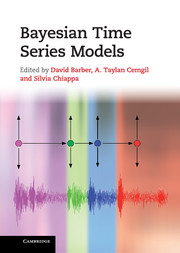Book contents
- Frontmatter
- Contents
- List of contributors
- Preface
- 1 Inference and estimation in probabilistic time series models
- I Monte Carlo
- II Deterministic approximations
- III Switching models
- 9 Physiological monitoring with factorial switching linear dynamical systems
- 10 Analysis of changepoint models
- IV Multi-object models
- V Nonparametric models
- VI Agent-based models
- Index
- Plate section
- References
9 - Physiological monitoring with factorial switching linear dynamical systems
from III - Switching models
Published online by Cambridge University Press: 07 September 2011
- Frontmatter
- Contents
- List of contributors
- Preface
- 1 Inference and estimation in probabilistic time series models
- I Monte Carlo
- II Deterministic approximations
- III Switching models
- 9 Physiological monitoring with factorial switching linear dynamical systems
- 10 Analysis of changepoint models
- IV Multi-object models
- V Nonparametric models
- VI Agent-based models
- Index
- Plate section
- References
Summary
Introduction
A common way to handle non-linearity in complex time series data is to try splitting the data up into a number of simpler segments. Sometimes we have domain knowledge to support this piecewise modelling approach, for example in condition monitoring applications. In such problems, the evolution of some observed data is governed by a number of hidden factors that switch between different modes of operation. In real-world data, e.g. from medicine, robotic control or finance, we might be interested in factors which represent pathologies, mechanical failure modes, or economic conditions respectively. Given just the monitoring data, we are interested in recovering the state of the factors that gave rise to it.
A good model for this type of problem is the switching linear dynamical system (SLDS), which has been discussed in previous chapters. A latent ‘switch’ variable in this type of model selects between different linear-Gaussian state spaces. In this chapter we consider a generalisation, the factorial switching linear dynamical system (FSLDS), where instead of a single switch setting there are multiple discrete factors that collectively determine the dynamics. In practice there may be a very large number of possible factors, and we may only have explicit knowledge of commonly occurring ones.
We illustrate how the FSLDS can be used in the physiological monitoring of premature babies in intensive care. This application is a useful introduction because it has complex observed data, a diverse range of factors affecting the observations, and the challenge of many ‘unknown’ factors.
- Type
- Chapter
- Information
- Bayesian Time Series Models , pp. 182 - 204Publisher: Cambridge University PressPrint publication year: 2011
References
- 1
- Cited by

